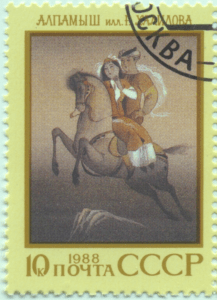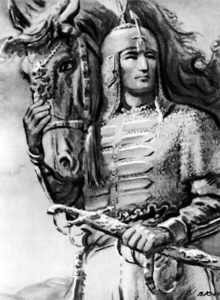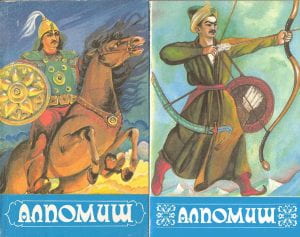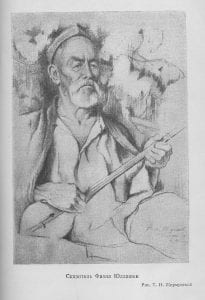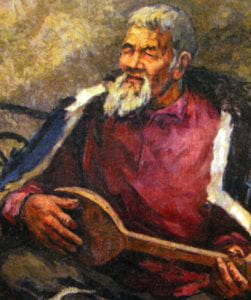Central Asia
earliest written version in 14th/15th century CE; continues to be performed orally
Anonymous,
Alpamish
The second part opens with Alpamish’s ride to the land of the Kalmyks where his father-in-law has remained, but is suffering under Kalmyk oppression. Alpamish is waylaid and imprisoned by the Kalmyk khan, while in the meantime at home his tribe is cruelly ruled by his half-brother Ultan, whose mother is a slave-woman. Ultan threatens to marry Barchin against her will. After seven years Alpamish is freed from his dungeon, with the help of the khan’s daughter, who has fallen in love with the prisoner and brings his horse to pull him out of prison by its tail. He returns home just in time to prevent Barchin’s remarriage.
The hero has slightly different names in different languages: in Uzbek he is called ‘Alpāmish’, in Kazakh and Karakalpak ‘Alpamıs’, in Tatar ‘Alpamsha’, in Bashkir ‘Alpamısha’, and in Altaian ‘Alıp-Manash’ (for surveys, see Chadwick and Zhirmunsky 1969: 292-96; Reichl 1992: 333-51). The genre term for the epic is dāstān in Uzbek, a loan-word from Persian, where its basic meaning is ‘tale’. This term is also found in other Turkic oral traditions. In many of these traditions the epic is composed in a mixture of verse and prose. The monologues and dialogues of the various protagonists are generally in verse, but descriptive passages, often typical scenes such as a battle or a journey on horseback, are also often in verse form. The progress of the action, on the other hand, is as a rule narrated in prose. The verse passages are sung and accompanied by the singer-narrator on a plucked or bowed string instrument. Many versions of Alpamish have extended verse passages. In 2018 an Uzbek version of the epic was published, which was recorded from a singer who was still alive in 2020 (Abdunazar Pāyānov, b. 1949). This version has over 14,000 lines of verse (ed. Eshānqulov and Chāriev 2018). There are also Alpamish versions in verse only, such as a Kazakh variant of the epic of over 4,000 lines, written down in the 1940s from the narrator-singer Abdirayim Baytursun-ulı (Qosan et al. 2006: 186-302). The most accomplished and one of the longest versions was recorded in the 1920s from the epic singer Fāzil Yoldāsh-oghli (1872-1955); the verse portions in this version comprise more than 13,000 lines (ed. Mirzaev and Abdurakhimov 1999).
While the latest version of Alpamish recorded is probably the version performed by the Uzbek singer Abdunazar Pāyānov, published in 2018, the earliest was published in 1901 in Tashkent. This version, which only comprises the first part of the epic, was collected by A. A. Divaev in 1896 from a Karakalpak epic singer. In the twentieth century a great number of versions were collected from Uzbek, Karakalpak and Kazakh singer-narrators. In Uzbek, for instance, more than forty versions of this epic have been written down (Mirzaev 1968; Reichl 2001:77-107).
In his detailed study of the Alpamish-story, Viktor Zhirmunsky classifies the various texts of the epic into four versions (1960). Zhirmunsky’s classification is based on plot as well as historical analysis and considerations regarding diffusion. The Uzbek, Kazakh and Karakalpak texts are grouped together as the so-called ‘Kongrat version’, named after a Turkic tribe that has played an important role in the formation of these three peoples. The ‘Kongrat version’ is characterized by placing the story in the world of the nomadic Turks, who are engaged in warfare against the Kalmyks.
Apart from the diffusion of the epic in Central Asia, it is also found in the area of the Urals and the Altay Mountains. The epic of Alpamısha transmitted among the Bashkirs of the southern Urals and the folktale of Alpamsha of their north-western neighbours, the Tatars, belong, according to Zhirmunsky, to the ‘Kipchak version’ of Alpamish. This version is named after the Turkic tribe of the Kipchaks, who ranged over the wide territory known as the Desht-i Kipchak, the Kipchak steppe in southern Russia. The Altaian version of Alpamish is unique. It is known in the version of only one singer, N. U. Ulagashev (1861-1946). Unlike the other versions of the epic, Ulagashev’s Alıp-Manash, while conserving the outlines of the Alpamish-plot, is cast in the form of Altaian epics, with their highly parallelistic and hyperbolic style and their frequent admixture of shamanistic elements (e.g., shape-shifting).
While all these versions were written down comparatively recently, a version of the epic has also survived from the late Middle Ages, preserved as the ‘Tale of Bamsı Beyrek’ in the Book of Dede Korkut (Zhirmunsky’s ‘Oghuz version’). This tale, in a mixture of prose and verse, is preserved in two sixteenth-century manuscripts (Dresden and Vatican) and belongs according to its linguistic form, like the other texts of the Book of Dede Korkut, to the 14th/15th century. There can be no doubt that the ‘Tale of Bamsı Beyrek’ is an early form of the Alpamish epic. This means, as Zhirmunsky has argued, that the Oghuz tribes must have brought this tale to Anatolia from their home in Central Asia. This speaks for an origin of the Alpamish tale before the Oghuz’ migration to the west from the eleventh century onwards. While in Anatolia the story has been adapted to the contemporary context of the Oghuz-Turks, so also has the tale been transformed in Central Asia. The enemies of Bamsı Beyrek and his tribe are men of the Christian king Shökli, but the enemies of Alpamish are Kalmyks, with whom the Turks were involved in warfare only centuries later. Zhirmunsky has postulated a history of the Alpamish tale that begins in the southern foothills of the Altay Mountains between the sixth and the eighth century (the period of the Second East Turkic Empire). The Altaian version with its archaic traits is testimony to this tradition. The story then spread to the lower reaches of the Syr-Darya with the Oghuz and spread from there among the Kipchaks before the time of the Mongolian invasions (13th century). The ‘Kongrat version’ of the epic was developed only later among the Uzbek tribe of the Kongrat some time in the sixteenth century. Not all scholars are in agreement with the details of this itinerary, but its outlines show a high degree of plausibility.
What makes this epic so precious for world literature is not only the power of its narrative and poetry, but also its close similarity, especially in the so-called ‘Kongrat version’, to the homecoming of Odysseus in the Odyssey. Zhirmunsky pointed out this similarity (1967) and presented persuasive arguments for the presence of an identical narrative pattern and motif sequence in the Greek and Turkic tale. The parallels have been taken up by classicists (e.g., Jensen 2017; Ready 2014). This deeper chronological level poses a number of intriguing questions concerning both the diffusion of Greek tales in Central Asia and the narrative sources of the later Turkic tribes. Whatever the pre-history of the tale of Alpamish, it is remarkable that in Central Asia oral tradition has lasted into the twenty-first century.
Karl Reichl
University of Bonn (Germany)
Works Cited
Chadwick and Zhirmunsky 1969: Chadwick, N. K. & V. Zhirmunsky. 1969. Oral Epics of Central Asia. Cambridge.
Eshānqulov and Chāriev 2018: Eshānqulov, J. & R. Chāriev, eds. 2018. Alpāmish. Ozbek khalq dāstāni. Aytuwchi: Ozbekistān khalq bakhshisi Abdunazar Pāyānov [Alpāmish. An Uzbek folk dastan. Narrator: Uzbekistan’s folk bakhshi Abdunazar Pāyānov]. Tashkent.
Jensen 2017: Jensen, M. S. 2017. ‘The Challenge of Oral Epic to Scholarship.’ Humanities 6: 97. <https://www.mdpi.com/2076-0787/6/4/97>
Mirzaev 1968: Mirzaev, T. 1968. Alpāmish dāstānining ozbek variantlari [The Uzbek variants of the epic Alpāmish]. Tashkent.
Mirzaev and Abdurakhimov 1999: Mirzaev, T. & M. Abdurakhimov, eds. & trs. 1999. Alpamysh. Uzbekskiy narodny geroicheskiy èpos [Alpāmish. An Uzbek heroic folk-epic]. Tashkent.
Qosan et al. 2006: Qosan, S. et al. (eds.) 2005. Babalar sözi. 34. Batırlar zhırı [The words of the forefathers. 34. The heroic epic]. Almaty.
Ready 2014: Ready, J. L. 2014. ‘ATU 974 The Homecoming Husband, the Returns of Odysseus, and the End of Odyssey 21.’ Arethusa 47: 265-85.
Reichl 1992: Reichl, K. 1992. Turkic Oral Epic Poetry: Traditions, Forms, Poetic Structure. New York. (Rpt. Routledge 2019)
Reichl 2001: Reichl, K., ed. & tr. 2001. Das usbekische Heldenepos Alpomish. Einführung, Text, Übersetzung. Turcologica 48. Wiesbaden.
Zhirmunsky 1960: Zhirmunsky, V. M. 1960. Skazanie ob Alpamyshe i bogatyrskaya skazka [The tale of Alpamysh and the hero tale]. Moscow.
Zhirmunsky 1967: Zhirmunsky, V. M. 1967. ‘The Epic of ‘Alpamysh’ and the Return of Odysseus.’ In Proceedings of the British Academy 52 (1966): 267-86.
Resources
Suggested reading in English:
Chadwick and Zhirmunsky 1969: Chadwick, N. K. & V. Zhirmunsky. 1969. Oral Epics of Central Asia. Cambridge.
Jensen 2017: Jensen, M. S. 2017. ‘The Challenge of Oral Epic to Scholarship.’ Humanities 6: 97. <https://www.mdpi.com/2076-0787/6/4/97>
Reichl 1992: Reichl, K. 1992. Turkic Oral Epic Poetry: Traditions, Forms, Poetic Structure. New York. (Rpt. Routledge 2019)
Zhirmunsky 1967: Zhirmunsky, V. M. 1967. ‘The Epic of ‘Alpamysh’ and the Return of Odysseus.’ In Proceedings of the British Academy 52 (1966): 267-86.
From the 1958 edition and Russian translation of the Uzbek epic in Fāzil Yoldāsh-oghli’s version.
Cover pictures of the two volumes of the 1993 edition of the Uzbek epic in Fāzil Yoldāsh-oghli’s version.
Drawing by T. N. Zhirmunsky in V. M. Zhirmunsky and Kh. T. Zarifov, Uzbekskiy narodny geroicheskiy èpos [The Uzbek heroic folk epic]. Moscow, 1947.
N. U. Ulagashev: painting of the Altaian singer of Alıp-Manash N. U. Ulagashev (1861-1946).
Alpamish statue in Termez, Uzbekistan.
Archive of Turkish Oral Narrative (ATON), Texas Tech University.
“Oral Folklore of Uzbekistan,” Intangible Cultural Heritage of Uzbekistan.
“Characteristics of the Oral Tradition and Dostons as Intangible Cultural Heritage of Central Asia,” Intangible Cultural Heritage of Uzbekistan.
Audiofile of an extract from the Uzbek version of Alpamish recorded in 1981 from the singer Chāri Khojamberdi-oghli:
An excerpt of the second part of Alpamish, performed by the Uzbek singer Abdunazar Pāyānov, whose version was published in 2018:
The beginning of a Kazakh version of Alpamıs:
Alpamysh sung with dombra accompaniment by Shoberdi Bakhshi:

